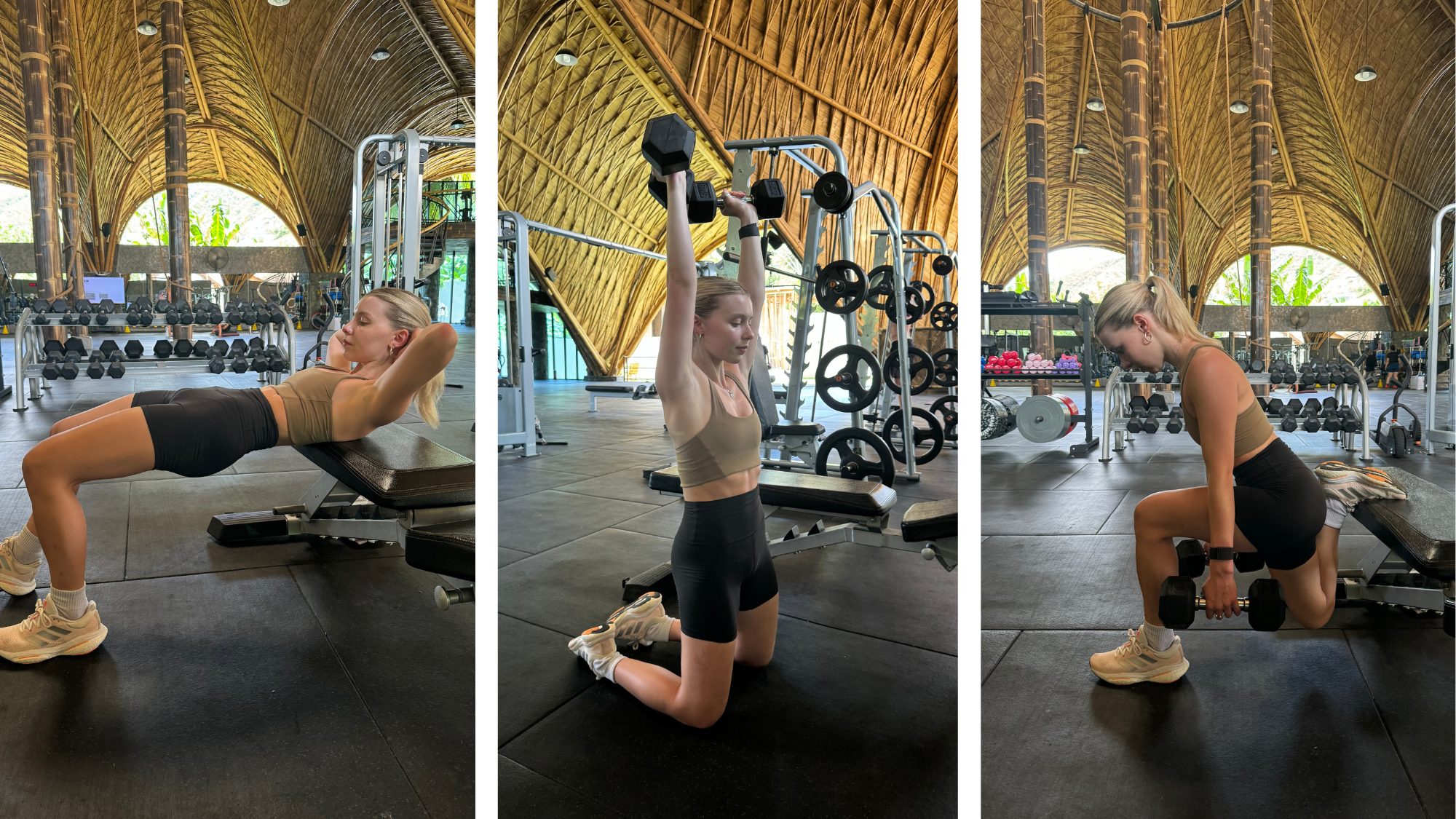I've never stuck to a workout plan before - but this three-day workout split has transformed my training
Full-body workouts have become my go-to.


As a Health Writer and fitness trainer who tries workout trends for a living, trust me when I say I've tried a fair few things in my time. From gruelling HIIT workouts five times a week (not the one), to one or two Pilates sessions, I've long been on the hunt for the perfect workout split to suit both my lifestyle and body.
While I know weight training makes me feel both physically and mentally strong, it's taken me a while to figure out how many strength sessions a week is optimum. The NHS website recommends aiming for a minimum of two strength sessions a week as a baseline, but for anyone who's already fairly active, you'll want to aim for one or two more than that. It's a fine line, though - squeeze in too many sessions and you risk overtraining and injury, while banking too few means you're unlikely to maintain or improve your fitness levels.
Not sure what I mean when I say "workout split"?. Let me explain. A workout split is, as the name suggests, simply a phrase to describe the way you divide your workouts throughout your week. It's used to describe both the frequency of your workouts - for instance, a four-day workout split would mean four workouts a week - and the type of workouts you're doing: an upper-lower split would mean you have workouts dedicated to your upper body and different training days for your lower body.
Now, onto the workout split that I've fallen in love with: a three-day, full-body workout split designed by personal trainer Shona Vertue for her Sculpt guide. I initially bought the plan because I love Vertue's attitude to exercise and movement. A yogi and strength trainer, she's long preached about how key strength training workouts, mobility for a functional body, and stress-busting practices like breathwork and meditation are for your overall wellbeing. And after three months of testing her plan out, I have thoughts on why it's so brilliant. Don't miss our guides to strength training for beginners, low impact strength training, and the benefits of strength training, while you're at it.
Your guide to building an effective workout split
Why I decided to go for a 3-day full body workout split
I've never stuck with a pre-programmed workout in my life before this one (hence why I'm so keen to rave about it). I've also never had a personal trainer (while I'd love one, it's not the most affordable) and find the number of gym programmes out there, all of which offer something different, incredibly overwhelming.
Instead, I've always written my own workout schedule - I am a qualified fitness instructor, after all. I decided to give Vertue's a try as I wanted someone I could trust to tell me how best to build a resilient body. I've been trying to get back into training after an injury, you see, and wanted to take the guesswork out of my workouts. (Another perk of her workout split specifically - her guide is much more affordable than training with a PT, but it feels like you have a personal trainer guiding you through the sessions).
She opts for a three-day, full body split in her guide for the simple reason that it's manageable but also effective for working out a wide range of muscles and maintaining and likely improving your fitness levels. Of course, it's important to note here that what workout split you opt for needs to fit both your body and lifestyle. You may prefer a two-day split focused solely on legs if you're a runner looking to injury-proof your body. Similarly, if you work from home a lot and your focus this year is your arms, a four-day, upper-body split may suit you best. What's key is working out what works for you and your body.
Celebrity news, beauty, fashion advice, and fascinating features, delivered straight to your inbox!
5 benefits of opting for a workout split
1. You'll easily be able to up your workout volume
People worry that a full-body split that uses every muscle within the allocated workout time is less effective than body-part-specific splits. The latter can be great if you have multiple days a week to train in the gym, but for people like me who can only go to the gym a few times, a full-body split that works for muscle groups a few times a week can be more beneficial.
It's all because of volume - meaning how much a muscle is worked. The more times it's worked over the week, the faster your gains, and I noticed that with this routine.
2. It'll save you time
Vertue designed this programme with busy people in mind. She tells me: "I've always tried to provide programmes that take into consideration that people have lives outside of fitness - which I often feel like the fitness industry forgets."
So, why three days? Well, "Three is usually the minimum effective dose when it comes to getting results and allows for us to create enough of a stimulus that causes the body to change."
3. It's simple
Honestly - and this may be incredibly obvious to everyone reading - I can not explain how easy following a programme has made my life. At a time when my brain was in overdrive, not having to pre-prepare a workout routine has been the difference between getting in a workout and skipping it.
Vertue offers every piece of information you'll need, including the kit, the variation or positioning, exercise videos to check your form against, the reps, the intensity and the rest break, making it so straightforward to follow.
4. You can add personal touches
That isn't to say you absolutely have to follow the programme to an absolute tee. It's called a workout "guide" for a reason: you're allowed to adapt it based on your own preference, skill and environment. For instance, I don't have a cable machine at my gym, so I swap cable exercises for resistance bands or dumbbell versions. There are also times when I've adapted tri-sets (three exercises performed back-to-back without rest) into a superset (two exercises performed back-to-back without rest) and a straight set, because I knew I didn't have the energy to keep moving for that long or a piece of kit wasn't free.
While Vertue offers guidance for how to spend your off-plan days, the fact it's just three days a week means you have loads of time to work on individual fitness goals. "It also allows for you to add another two workouts a week for anything specific you're working on, like handstands or running," agrees Vertue.
5. You'll have adequate time to recover
Opting for a three-day workout split means you'll be working your muscles an adequate amount but also leaving yourself adequate time for recovery, too - absolutely key for making sure you don't over-train, fatigue your muscles, or risk injury.
A post shared by Shona Vertue (@shona_vertue)
A photo posted by on
"I tried a three-day workout split and it was game-changing for my fitness"
Month one
As I mentioned, I was a complete newbie to following guides before, so I was very happy when I saw that Vertue's plan comes in a PDF with Excel documents and hyperlinked videos. Some people might prefer to use an app with an interface, but I loved this format and how simple it was to follow.
I took my plan to the gym with me and got to grips with the workouts for the first few weeks. Every session felt very well-rounded, including moves that worked with push and pull patterns for the upper and lower body in every workout.
A huge focus in Vertue's programming is on glute exercises - and not just for aesthetic reasons. Given we spend so long sitting down, with the muscles in the front of our bodies shortening and the muscles in the back of our bodies weakening, our butts can get pretty tired. And that matters: your glutes are the biggest muscle in your body and are used to stabilise the pelvis and spine meaning any weakness can lead to aches, pains and injuries. Not with Vertue's guide: every single day we worked on glute-dominant exercises such as hip thrusts, split squats and walking lunges.
I'm not going to lie, the post-workout soreness I felt after the first few workouts was intense, but I immediately started noticing the difference in my strength.
Month two
Come month two, the workouts in Vertue's plan have changed (they change every four weeks). While the split remains the same - it's still three full-body workouts - some of the exercises have gotten an upgrade. For instance, we've moved from box squats to full barbell back squats (the latter removes the support and makes it more challenging) and machine presses to TRX presses (reducing stability and increasing muscle activation).
That's essential for progressive overload, meaning increasing the challenge on the muscles to continue to grow strength and size. The reps have also changed. In some moves, we're doing fewer reps to encourage heavier weights and in others, we're doing more reps for an extra challenge. You'll notice that the rep ranges in some of Vertue's workouts are higher than you might see in a typical plan - for instance, we do 15 reps of hip thrusts four times. There's a method to that madness, she says. "Given the majority of my clients are women, it's programmed because they can handle higher volume work. That is to say, we recover faster and can therefore take on much more workload - this has to do with the way our hormonal system functions - and we need to make sure we're creating enough of a stimulus to cause the body to change and adapt."
"One important caveat to mention is that we use reps in reserve (RIR) which is a training method where you stop a set of an exercise before reaching complete failure, leaving a certain number of reps 'in reserve'. This approach helps manage fatigue, reduces the risk of injury, and can improve long-term strength and muscle gains by allowing for more consistent training. This means that even though we're lifting 'lighter' for a larger number of reps, we are still working close to 'failure'."

Chloe trying Vertue's three-day workout split
Month three
Things really step up over the next four weeks. I'm talking chin ups, pistol squats and TRX jackknives. Luckily, we've been prepped for this: all of the movements are progressions of movement patterns we've been working on for the past eight weeks.
I had a three week break between month two and three, so in order to scale up my workout I first scale it down - repeating another week of month two to ensure my body is ready for these advanced moves.
I find when I come to it, I love the new challenges. It feels like a real test of what my body is capable of and being able to get through these workouts is satisfying evidence of how hard I've worked in the months prior - and how well-put-together the plan is.
One huge benefit of Vertue's plan is that it also comes with a meditation and journaling prompts. "Based on the feedback I've received, they've been so helpful for not just habit setting and discipline but also connecting to a deeper 'why' behind training. The questions are inspired by work I've been doing at university [studying psychology], particularly around Cognitive Behavioural Therapy and how much it can support diet and exercise routines," says Vertue. And I agree: as with everything, it's not just the physical work you put in that helps you meet your goals, but also how you think about your goals makes a huge difference to your outcomes.
Shop MC UK's go-to workout kit:

Keen to invest in a pair of gym leggings that will last the test of time? There's a reason the Sweaty Betty Power leggings make MC UK's list of the best gym leggings - they're supportive, sweat wicking, high-waisted and compressing.
What is the most effective workout split?
Personal trainers have long agreed to disagree on this one, and while it's hotly debated in the fitness sphere, one thing's for certain: the most effective workout split for you is the one that suits both your body and lifestyle.
Personal trainer Shona Vertue prefers a three-day full body workout split because not only will it improve your fitness, but it gives you time to tag on a run or Pilates session if you fancy and have time, too. "It allows for you to add another two workouts a week for anything specific you're working on, like handstands or running," she shares.
She continues: "Three is usually the minimum effective dose when it comes to getting results and allows for us to create enough of a stimulus that causes the body to change."

Chloe Gray is a freelance journalist who writes and talks about health, fitness, and wellbeing through a feminist lens. She was part of the launch team for Stylist magazine's fitness brand, Strong Women, and has written for i news, Women's Health, Red magazine, Good Housekeeping, Refinery29, and more. She's all about building mental and physical strength, eating delicious food that fuels you well, and making the fitness industry more accessible and enjoyable. She's also a qualified fitness trainer and research nerd, so you can be sure everything you read is backed by proper science.

